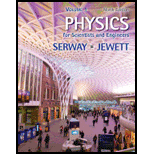
A Doppler weather radar station broadcasts a pulse of radio waves at frequency 2.85 GHz. From a relatively small batch of raindrops at bearing 38.6° east of north, the station receives a reflected pulse after 180 µs with a frequency shifted upward by 254 Hz. From a similar batch of raindrops at bearing 39.6° east of north, the station receives a reflected pulse after the same time delay, with a frequency shifted downward by 254 Hz. These pulses have the highest and lowest frequencies the station receives, (a) Calculate the radial velocity components of both batches of raindrops. (b) Assume that these raindrops are swirling in a uniformly rotating vortex. Find the angular speed of their rotation.
(a)
The radial velocity components of both batches of raindrops.
Answer to Problem 39.69AP
The radial velocity component of first batch of raindrops is
Explanation of Solution
Given info: The frequency of radio waves is
Write the equation of frequency of radio waves received.
Here,
Write the equation of frequency of radio waves received for another upward shift.
Here,
Substitute
The frequency of radio waves received for upward shift is,
Here,
Substitute
Thus, the value of
Substitute
Thus, the radial velocity of the radio waves with the upward shift is
The frequency of radio waves received for downward shift is,
Here,
Substitute
Thus, the value of
Substitute
The radial velocity of the radio waves with the downward shift is
Conclusion:
Therefore, the radial velocity component of first batch of raindrops is
(b)
The angular speed of the rotation.
Answer to Problem 39.69AP
The angular speed of the rotation is
Explanation of Solution
Given info: The frequency of radio waves is
Write the equation of angular speed of the vortex.
Here,
Write the equation for radius of vortex.
Here,
The radio waves travels towards the rain and comes back.
Write the equation for one way distance covered by the rain.
Here,
Substitute
Substitute
Substitute
Conclusion:
Therefore, the angular speed of the rotation is
Want to see more full solutions like this?
Chapter 39 Solutions
Physics for Scientists and Engineers, Volume 1
- What fuel economy should be expected from a gasoline powered car that encounters a total of 443N of resistive forces while driving down the road? (Those forces are from air drag, rolling resistance and bearing losses.) Assume a 30% thermodynamic efficiency.arrow_forwardNo chatgpt pls will upvotearrow_forward12. What is the angle between two unit vectors if their dot product is 0.5?arrow_forward
- If the car in the previous problem increases its power output by 10% (by pressing the gas pedal farther down), at what rate will the car accelerate? Hint: Consider the net force. In the previous problem the power was 31.8kWarrow_forwardWhat power is required (at the wheels) for a 1400 kg automobile to climb a 4% grade at a constant speed 30 m/s while it is opposed by drag and rolling resistance forces totaling 500 N?arrow_forwardNo chatgpt pls will upvotearrow_forward
- As a box is lifted against gravity and placed on a shelf, how does the work done by the lifter compare with the work done by gravity? What is the net work done on the box? What does this imply about its change in kinetic energy? Use definitions and mathematics from this chapter to answer these questions.arrow_forwardAs I carry a box up a flight of stairs, am I doing positive work or negative work on the box? Provide a mathematical explanation.arrow_forwardAs a ball falls under the influence of gravity, does gravity do positive work or negative work? Provide a mathematical explanation.arrow_forward
 Physics for Scientists and Engineers: Foundations...PhysicsISBN:9781133939146Author:Katz, Debora M.Publisher:Cengage Learning
Physics for Scientists and Engineers: Foundations...PhysicsISBN:9781133939146Author:Katz, Debora M.Publisher:Cengage Learning Principles of Physics: A Calculus-Based TextPhysicsISBN:9781133104261Author:Raymond A. Serway, John W. JewettPublisher:Cengage Learning
Principles of Physics: A Calculus-Based TextPhysicsISBN:9781133104261Author:Raymond A. Serway, John W. JewettPublisher:Cengage Learning
 Physics for Scientists and Engineers, Technology ...PhysicsISBN:9781305116399Author:Raymond A. Serway, John W. JewettPublisher:Cengage Learning
Physics for Scientists and Engineers, Technology ...PhysicsISBN:9781305116399Author:Raymond A. Serway, John W. JewettPublisher:Cengage Learning Glencoe Physics: Principles and Problems, Student...PhysicsISBN:9780078807213Author:Paul W. ZitzewitzPublisher:Glencoe/McGraw-Hill
Glencoe Physics: Principles and Problems, Student...PhysicsISBN:9780078807213Author:Paul W. ZitzewitzPublisher:Glencoe/McGraw-Hill Physics for Scientists and EngineersPhysicsISBN:9781337553278Author:Raymond A. Serway, John W. JewettPublisher:Cengage Learning
Physics for Scientists and EngineersPhysicsISBN:9781337553278Author:Raymond A. Serway, John W. JewettPublisher:Cengage Learning





